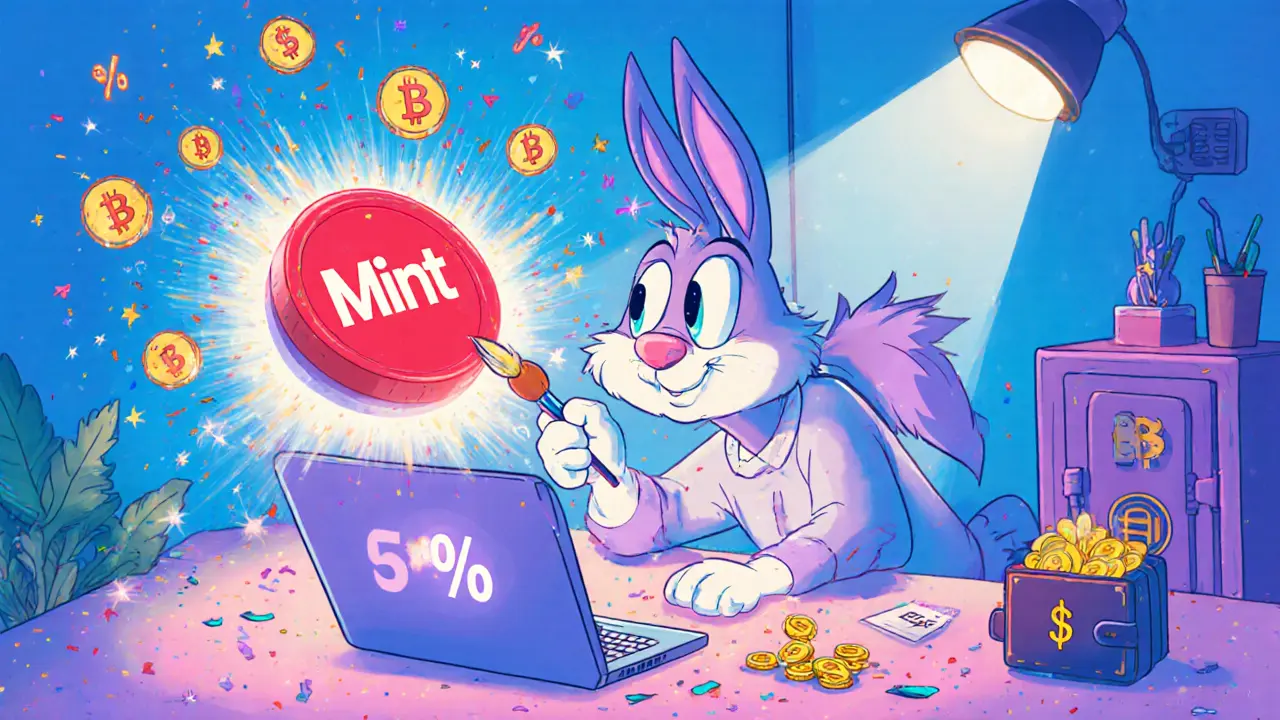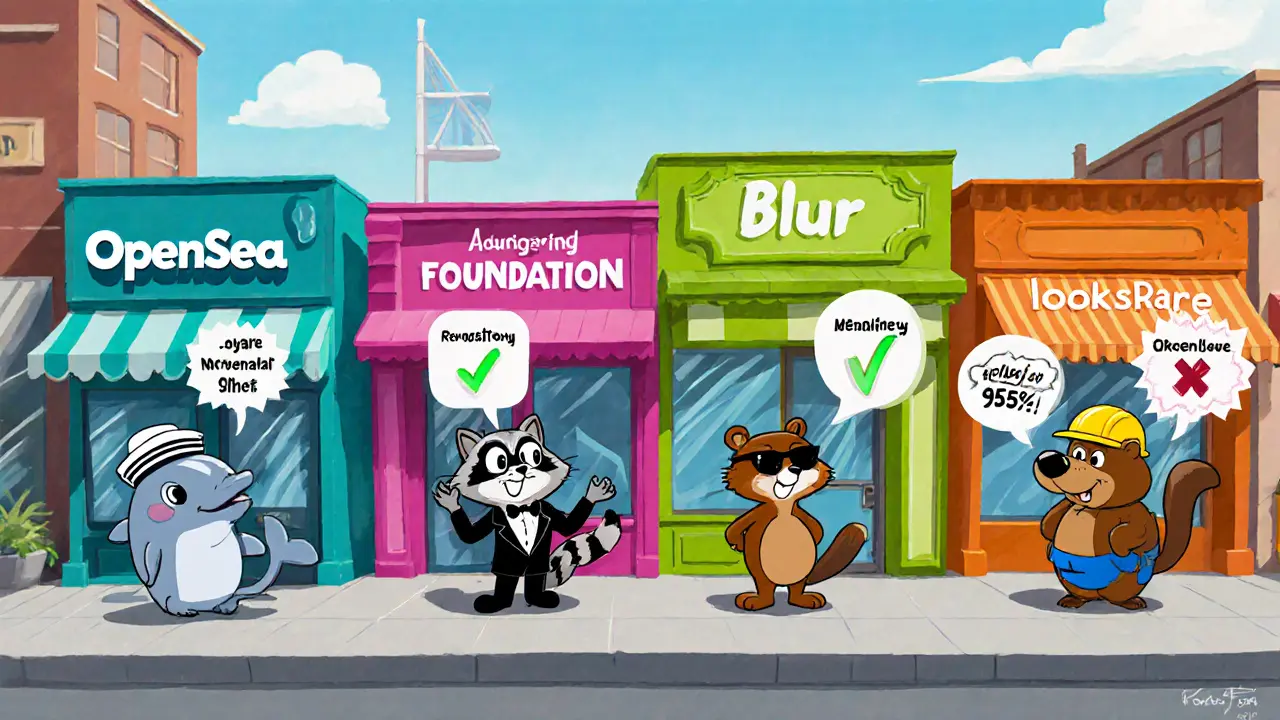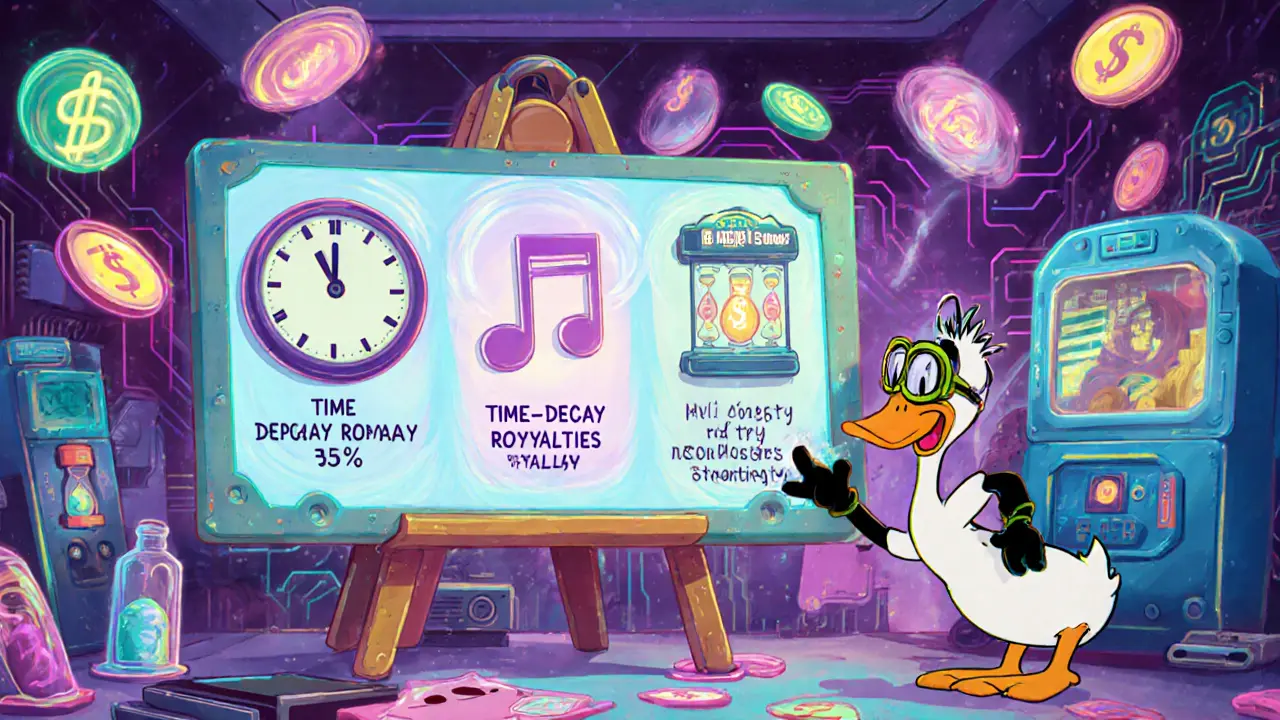
NFT Royalty Calculator
Estimated Royalty Earnings
Sale Price:
$10,000
Royalty Percentage:
5%
Estimated Royalty Earned:
$500
Marketplace Royalty Compliance
Not all marketplaces enforce royalties. Here's how popular platforms handle royalty payments:
| Marketplace | Royalty Policy | Compliance Rate |
|---|---|---|
| OpenSea | Enforced (Creator Earnings) | ≈95% |
| Foundation | Enforced (mandatory royalties) | ≈90% |
| Blur | Optional (royalties can be omitted) | ≈60% |
| LooksRare | Optional, royalty-friendly mode | ≈65% |
Choose platforms that enforce royalties to maximize your earnings potential.
When creators talk about NFT is a non‑fungible token that records a unique digital asset on a blockchain, the first thing most people wonder: can this tech actually replace a traditional copyright contract? The short answer is yes-if you set it up right. By embedding a royalty clause into the token’s code, creators can collect a slice of every future resale forever. Below is a practical guide that walks you through the whole process, from minting to cashing out, and explains the trade‑offs you’ll face on today’s major marketplaces.
Key Takeaways
- Royalty percentages are programmed into the smart contract at mint‑time and paid out automatically on each secondary sale.
- Ethereum‑based standards like ERC‑721 and ERC‑1155 support royalty fields, while EIP‑2981 is becoming the universal fallback.
- Marketplace compliance varies: "royalty‑enforced" platforms (OpenSea, Foundation) keep creator earnings, whereas "optional" venues (Blur, LooksRare) often skip them.
- Typical royalty rates sit between 2.5% and 15%; the sweet spot for most creators is 5‑6% to balance incentive and resale appeal.
- Tax and gas costs still apply, so factor in transaction fees (≈$50‑$200 on Ethereum mainnet) when budgeting your earnings.
1. How NFT Royalties Work Under the Hood
During the minting process, the creator defines a royalty percentage inside the token’s smart contract. When the NFT changes hands, the blockchain automatically executes a small piece of code that sends the agreed‑upon slice of the sale price to the creator’s wallet. No middlemen, no paperwork.
For example, an artist mints a piece for $1,000 with a 5% royalty. If a collector later flips it for $10,000, the smart contract routes $500 straight to the artist’s address. Every subsequent resale repeats the same calculation, creating a potentially infinite revenue stream.
The two most common token standards that make this possible are ERC‑721 (single‑asset NFTs) and ERC‑1155 (multi‑asset, semi‑fungible tokens). Both allow a royalty field that complies with EIP‑2981, which standardizes how marketplaces read the royalty data.
2. Choosing the Right Marketplace
Not all NFT marketplaces honor the royalty data the same way. Some platforms embed the royalty payout into the sale transaction, while others give the seller the option to skip it. Below is a quick side‑by‑side comparison.
| Marketplace | Royalty Policy | Compliance Rate (2023‑24) | Typical Platform Fee |
|---|---|---|---|
| OpenSea | Enforced (Creator Earnings) | ≈95% | 2.5% + gas |
| Foundation | Enforced (mandatory royalties) | ≈90% | 15% creator cut + gas |
| Blur | Optional (royalties can be omitted) | ≈60% | 0% maker fee, 0.5% taker fee |
| LooksRare | Optional, royalty‑friendly mode | ≈65% | 2% total fee |
If you value consistent payouts, stick with platforms that label royalties as “mandatory.” If you’re targeting high‑frequency traders, you might list on an optional platform and accept that some sales will forgo the royalty.

3. Setting Up Your Royalty Structure
Most user‑friendly minting tools (OpenSea, Foundation, SuperRare) let you input a royalty percentage with a simple slider-no coding required. Here’s a quick checklist to avoid common pitfalls:
- Pick a realistic percentage. Too high (e.g., >12%) can scare buyers; too low (<2%) cuts your long‑term earnings.
- Consider split royalties. If you co‑created the work, many platforms let you assign % shares to multiple wallets.
- Plan for gas spikes. Ethereum fees can swing wildly; budgeting $100‑$200 per mint is a safe estimate for 2025.
- Account for taxes. Royalty income is usually treated as self‑employment earnings in most jurisdictions.
- Document the royalty terms. Keep a screenshot of your settings; if a marketplace later removes the royalty, you have proof for potential legal action.
4. Real‑World Numbers: What Creators Are Earning
Data from the 2024 market report shows that total royalty payouts across major platforms topped $150million in 2023. A mid‑tier visual artist who minted 20 pieces at a 5% royalty saw the following cash flow:
- Initial sales: $30,000 total.
- Secondary sales (average resale price $4,000, 3 flips per piece): $2,400 per piece in royalties, or $48,000 total.
- Net after gas and tax: ≈$70,000 in the first 18 months.
Even lower‑profile creators report receiving $200‑$500 per month from royalty drips that started years after the original sale.
5. Challenges and Work‑arounds
While the tech is solid, the ecosystem still has friction points:
- Marketplace non‑compliance. Some platforms simply ignore royalty fields. The emerging “right‑of‑reclaim” model lets creators lock the token unless the royalty is paid, but it adds UX complexity.
- Off‑chain trades. Private sales outside any marketplace bypass the smart contract entirely, removing the royalty.
- Regulatory risk. The EU’s MiCA proposal may force platforms to enforce royalties by 2025, but it’s not yet law.
Creators mitigate these issues by:
- Choosing royalty‑enforced platforms for the bulk of their listings.
- Including a “royalty‑backed” clause in any private sale agreement.
- Staying active in community governance-voting on protocol upgrades that tighten enforcement.
6. Future Directions: Beyond Simple Resale Fees
Experts predict three major evolutions:
- Time‑decay royalties. The percentage drops each year, encouraging early trading while still rewarding creators long‑term.
- Utility‑linked royalties. NFTs that grant access (e.g., to a concert) could charge a fee each time the holder uses the utility, not just when they sell.
- Hybrid models. Projects like Royal and Catalog blend streaming royalties with resale royalties, offering an all‑in‑one revenue stream for musicians.
Adopting these models will likely require new standards (EIP‑xxxx) and more sophisticated smart contracts, but the core idea remains the same: creators get paid every time their work creates value.

Frequently Asked Questions
Do I need to know how to code to set up NFT royalties?
No. Most mainstream minting platforms let you choose a royalty percentage with a slider. Coding is only needed for custom split‑royalty contracts or dynamic rates.
What happens if a marketplace ignores my royalty setting?
If the platform is royalty‑optional, the contract won’t force a payout. You can either avoid listing there or include a legal clause in any private sale to enforce the fee.
Are NFT royalties taxable?
Yes. In most countries, royalty income is treated as self‑employment or royalty income and must be reported on your tax return. Keep detailed transaction records for each payout.
Can I change the royalty percentage after minting?
Generally no. The royalty data is baked into the smart contract at mint time. To adjust it, you’d need to mint a new token or use a contract that supports updatable royalty fields.
Which blockchain offers the lowest gas fees for royalties?
Layer‑2 solutions like Polygon or Immutable X reduce fees dramatically (often under $1 per transaction) while still supporting ERC‑721/EIP‑2981 royalty standards.

Stefano Benny
July 19, 2025 AT 06:46NFT royalty mechanics are basically a glorified fee‑splitting protocol, not the revolutionary ownership model some hype machines sell 🤑. The smart contract just pushes a percentage of the sale price to a hard‑coded address, which you could achieve with a simple escrow service on any chain. If you strip away the buzzwords you see a plain profit‑sharing contract that anyone can duplicate. So the "unique ownership" claim feels more like a marketing veneer than a legal breakthrough. 🤖
Jenae Lawler
July 22, 2025 AT 18:06While the preceding exposition extols the virtues of perpetual royalties, one must consider the fiscal inefficiencies inherent in such mechanisms. The imposition of a mandatory percentage on secondary sales engenders market friction, potentially diminishing liquidity. Moreover, the reliance on platform‑enforced compliance introduces a centralised vector of failure, antithetical to the purported decentralised ethos. In light of these considerations, a judicious appraisal of royalties as a universal remedy appears premature.
Prince Chaudhary
July 26, 2025 AT 05:26Creators, think of royalties as a marathon, not a sprint. By embedding a modest percentage at mint‑time, you secure a stream that can fund future projects, experimentations, or community initiatives. Remember, the blockchain records are immutable, so your earnings persist beyond any single sale. Keep the percentage realistic, and you’ll cultivate a supportive collector base eager to see your work thrive.
emmanuel omari
July 29, 2025 AT 16:46Regarding the compliance stats, OpenSea’s ≈95% enforcement means creators can largely count on their royalties, whereas platforms like Blur, hovering around 60%, often leave creators short‑changed. The variance stems from how each marketplace implements EIP‑2981: some bake the royalty lookup into the sale transaction, others treat it as optional metadata. Hence, when choosing a venue, weigh both the compliance rate and the associated gas fees to optimise net earnings.
Andy Cox
August 2, 2025 AT 04:06i've seen a lot of creators jump on nft royalties without thinking about the gas costs it can really eat into profit especially on ethereum mainnet
Jan B.
August 5, 2025 AT 15:26Indeed, the gas overhead can be substantial. When budgeting, allocate an extra $50‑$200 to cover transaction fees, otherwise the royalty payout may be dwarfed by the cost of execution.
MARLIN RIVERA
August 9, 2025 AT 02:46The royalty fee is just a cash grab for lazy developers.
Debby Haime
August 12, 2025 AT 14:06Don’t let the fear of fees stall you! If you set a reasonable royalty-say 5%-you’ll still earn sizable returns on high‑volume secondary sales. Use the calculators to model your earnings and you’ll see the long‑term upside.
Courtney Winq-Microblading
August 16, 2025 AT 01:26One might contemplate the philosophical dimension of digital provenance: each token not only carries ownership but also a narrative thread that ties creator, collector, and community together. In this sense, royalties become a living contract of mutual recognition, not merely a fiscal instrument.
katie littlewood
August 19, 2025 AT 12:46When I first dipped my toes into the NFT space, the promise of perpetual royalties felt like a golden ticket to financial independence. Yet, as I navigated the myriad marketplaces, I discovered that the reality is a mosaic of platform policies, gas fees, and collector expectations. On OpenSea, the enforced royalty gave me a reliable baseline, but the 2.5% fee ate into my margins. Conversely, Blur’s optional model offered lower fees but left my royalty hopes hanging in the balance. The key takeaway? Blend strategic pricing with platform selection, and always run the numbers-your future self will thank you.
Chad Fraser
August 23, 2025 AT 00:06Yo, keep your royalty percentages chill. Too high scares buyers, too low leaves you broke. Find that sweet spot and watch the community bounce back.
Jayne McCann
August 26, 2025 AT 11:26Royalties aren’t the answer.
Richard Herman
August 29, 2025 AT 22:46Let’s step back and consider the broader ecosystem before we idolise NFT royalties as a panacea for creator compensation. First, the technical foundation-EIP‑2981-provides a standard, but its adoption is fragmented across platforms, resulting in inconsistent enforcement. Second, the economic incentive structure can inadvertently price out casual collectors, creating a stratified market where only high‑net‑worth participants engage. Third, the recurring transaction costs, especially on congested L1 networks, can erode the very royalties they aim to protect. Fourth, there is a legal ambiguity: while the smart contract records a royalty clause, it does not supersede existing intellectual property law, leaving creators vulnerable to jurisdictional disputes. Fifth, market volatility amplifies the risk; a token priced at $1,000 today could plummet, rendering a 10% royalty negligible. Sixth, the psychological impact on buyers is non‑trivial; repeated royalty charges may lead to buyer fatigue and reduced secondary market activity. Seventh, platform governance can shift policies, as seen when some marketplaces introduced optional royalty modes, underscoring the fragility of creator earnings. Eighth, the environmental footprint of on‑chain royalty execution, though improving, still contributes to the broader carbon concerns of blockchain technology. Ninth, there is an opportunity cost: creators might invest time in structuring royalty contracts rather than focusing on artistic development. Tenth, community perception matters; transparency about royalty splits can foster trust, while opaque structures breed suspicion. Eleventh, some creators have experimented with tiered royalty models, adjusting percentages based on resale price brackets, which adds complexity but can align incentives. Twelfth, integrating royalty payouts with fiat on‑ramps remains a hurdle for many artists seeking immediate liquidity. Thirteenth, the rise of royalty‑friendly platforms is encouraging, yet their market share is still limited. Fourteenth, cross‑chain interoperability could eventually mitigate some of these challenges, but standards are nascent. Finally, while royalties are a valuable tool, they should be part of a diversified revenue strategy that includes primary sales, licensing, and community-driven initiatives.
Parker Dixon
September 2, 2025 AT 10:06Great points, Richard! 🎉 Adding to that, many creators are now leveraging Layer‑2 solutions to slash gas fees, which makes the royalty model far more sustainable. Also, keep an eye on emerging cross‑chain royalty standards-they’ll likely smooth out the compliance gaps you mentioned.
Bobby Ferew
September 5, 2025 AT 21:26Honestly, the whole royalty hype feels like a buzzword‑filled sandbox where every creator pretends to be a mogul while the market silently bleeds. The jargon is intoxicating, but the bottom line remains: most artists still earn pennies after fees.
celester Johnson
September 9, 2025 AT 08:46We stand at the crossroads of digital art and capital extraction, where the promise of perpetual royalties morphs into a subtle form of techno‑feudalism. The blockchain, once heralded as a democratizing force, now enforces a new hierarchy: the token‑holder elite and the perpetual revenue‑seeker. Such a paradigm shift demands a philosophical reckoning, lest we trade artistic freedom for algorithmic rent.
John Kinh
September 12, 2025 AT 20:06Royalties are overrated 🙄. Just let the market decide.
Mark Camden
September 16, 2025 AT 07:26It is morally indefensible to exploit creators with optional royalty schemes that siphon value away from the very individuals who fuel the ecosystem’s growth. A society that tolerates such predatory practices betrays its own cultural heritage. Therefore, we must advocate for enforceable standards and hold platforms accountable for the welfare of artistic labor.
Evie View
September 19, 2025 AT 18:46Stop whining about fees and start making art that sells! If you can’t handle a 5% cut, you’re not cut out for the game.
Sidharth Praveen
September 23, 2025 AT 06:06Stay positive-set a modest royalty and watch it compound as your community grows!
Sophie Sturdevant
September 26, 2025 AT 17:26Remember, a well‑crafted royalty schema is a strategic asset. Keep the percentage within a market‑acceptable range, and reinforce it with clear licensing terms to protect your intellectual property.
Nathan Blades
September 30, 2025 AT 04:46The drama of perpetual royalties is akin to a modern myth: creators strive for immortality through code, yet they must wrestle with the very systems that promise freedom. Embrace the narrative, but remain grounded in pragmatic economics.
Somesh Nikam
October 3, 2025 AT 16:06Hey there! 😊 When you set up royalties, double‑check the smart‑contract fields to ensure the percentage is correctly encoded. A small typo can void the entire payout structure.
Michael Wilkinson
October 7, 2025 AT 03:26Let’s be clear: enforcing royalties is not a charitable act but a contractual obligation. Ignoring them undermines the very principle of fair compensation that underpins any professional exchange.